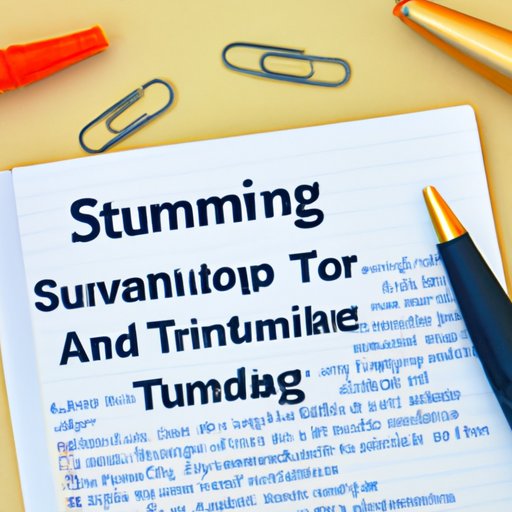
Introduction
Summarizing a longer piece of writing is a great way to condense a large amount of information into a more concise, easily digestible format. From academic papers to news articles, summarizing is an essential skill that can save time and help readers quickly understand the main points of a text. However, starting a summary can be challenging, especially when trying to create an opening that is clear and effective. In this article, we will explore tips and strategies for beginning a summary and creating a strong introduction to ensure a successful summary.
The Importance of Beginning With a Clear Introduction
Starting a summary with a clear introduction is essential to make sure that readers quickly understand the purpose and scope of the summary. By providing a clear overview, readers can decide if the content is relevant to their needs and continue reading. Furthermore, a clear introduction sets the tone for the rest of the summary and can help you stay focused and organized as you write.
Tips for Effective Summarizing
Here are six essential tips for starting a summary:
- Identify the main topic: Read through the document and determine the main topic or subject that the summary will focus on.
- Break it down: Break down the longer document into key points to create a stronger, more focused summary.
- Be objective: Always keep the tone of the summary objective and impartial. Avoid introducing any personal opinions or biases.
- Focus on the most important information: Keep the focus on the critical information that readers need to know, rather than trying to include every detail.
- Stay concise: Summaries are designed to be short and to the point. Make sure your summary is concise and to the point.
- Organize your thoughts: To make sure your summary flows logically and is easy to follow, organize your thoughts before you start writing.
Using Strong Keywords to Start Your Summary
As you start your summary, try to use strong keywords that can help guide your writing and grab your readers’ attention. Using keywords will help you create a more targeted and specific summary, making it easier for readers to quickly understand the main points of the text. Some examples of strong keywords include:
- Ultimately
- Therefore
- Overall
- Consequently
- Significantly
- Remarkably
How to Structure Your Summary
A typical summary structure includes an opening paragraph, a brief overview of the main points, and a conclusion that concludes the summary. This structure is easy to follow and can help you stay focused and concise as you write.
To begin, start your introduction with a sentence or two that provides an overview of the document. Then, include a sentence or two about the author’s main argument or points and summarize the purpose of the text. Finally, conclude the opening paragraph with a thesis statement or a sentence that clearly states the purpose of your summary.
Common Mistakes to Avoid in Summarizing
When starting a summary, six mistakes should be avoided:
- Don’t introduce personal opinions: Summaries should be objective and impartial, so avoid adding personal opinions or biases to your writing.
- Avoid going on tangents: Focus on the most important information and avoid straying off-topic.
- Don’t include irrelevant details: Only include details that are necessary to understanding the main points of the text.
- Don’t include everything: Summaries are designed to be shorter than the original document, so avoid trying to include every detail.
- Stay concise: Keep your summary concise and to the point, avoid wordy sentences and unnecessary phrases.
- Don’t include too much technical language: Summaries should be accessible to a broad audience, so avoid using technical language and complex terms that may not be understood by readers who are unfamiliar with the subject matter.
Examples of Great Summary Introductions
Here are a few different types of great summary introductions that you can use as inspiration:
- Starting with a question: Ask a question that will grab your readers’ attention and encourage them to continue reading.
- Starting with a quote: Use a quote from the text to provide readers with a glimpse of what’s to come in the summary.
- Starting with a surprising statistic: Use a surprising or interesting statistic to immediately engage readers and highlight the significance of the text.
Conclusion
Starting a summary can be challenging, but by following these tips and strategies, you can create a clear and effective introduction that will engage readers and set the tone for the rest of your summary. Remember to focus on the most important information, stay concise, and avoid common mistakes like introducing personal opinions or unnecessary details. With practice, you’ll soon be able to begin your summaries with confidence and efficiency.




